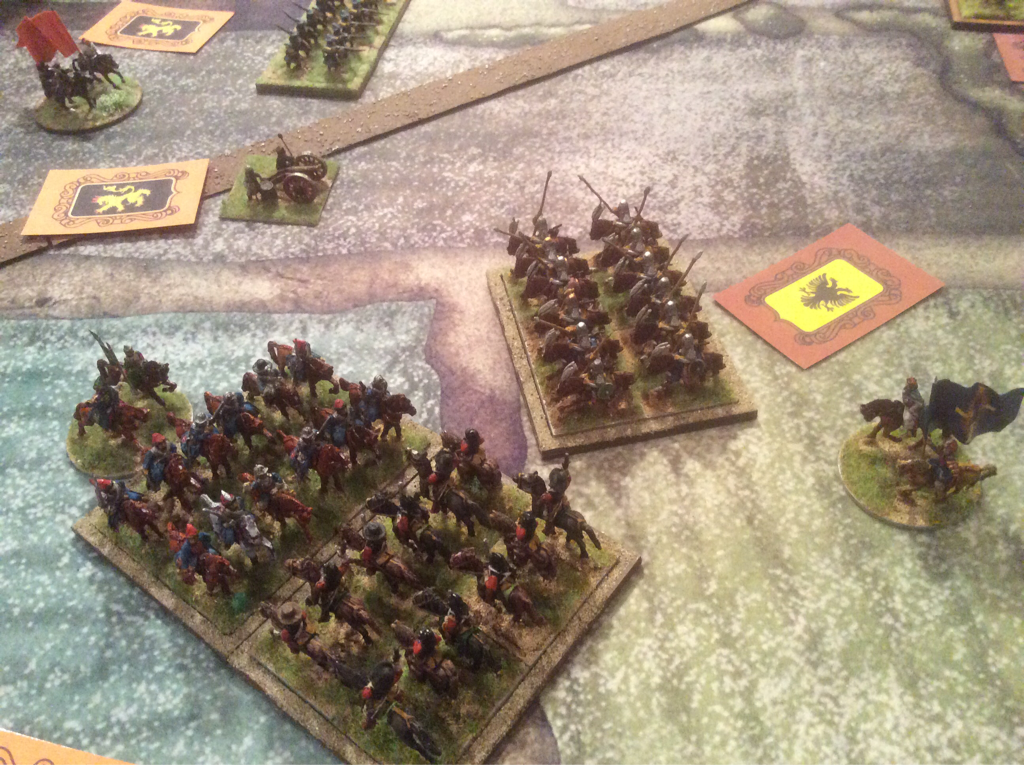|
Summary for the skim reader: Tercios is elegant, fast moving, full of period flavour and great fun to play. Kingdoms provides essential extra rules and army lists for Eastern Europe and the ECW. A free PDF of the basic rules is available at
http://elkraken.es/released/en/. Give it a try. Mechanics On 24 February we ran through a quick action using Tercios and its supplement for Eastern Europe and the ECW, Kingdoms. It was an interesting and decisive encounter. I found the rules much easier to demonstrate than describe. Each unit has a whopping 10 factors on its Stats line, each used for a different situation. 6 of these are 'active' factors and 4 are used by the enemy in different fire and melee situations. Before you walk off in disgust, this is the most complicated element of the rules and the engine of the system is elegant, simple and intuitive. Speed is a basic allowance in inches. Every other active factor represents the number of six sided dice to be thrown against that quality. An increase or decrease in a factor reduces the number of dice to roll: the target number doesn't change, just the number of dice you are rolling. We learned pretty quickly what we needed to roll for each test. It helps to have played Dreadball, which has a similar system. Each turn begins with the selection of orders for each unit on both sides. The options are Ready, the vanilla order allowing any two actions from a short list including fire at reduced effectiveness; Assault, with increases to speed and melee factors; Run, putting everything into speed; Fire, allowing a salvo at full effect; and Resist, which allows a unit to recover damage. Each card also has a Reaction function that can be taken as an interrupt when enemy either declares an assault on the unit or moves within 3". The reaction on a card can be subtly different from its Order, so for example Musket-armed foot who fire as a reaction to an enemy charge receive a bonus that they wouldn't have got had they fired as an action. However, a unit must pass an order check to react that it might fail, so deciding when to activate a unit can be a tricky challenge. Players then roll for initiative and one of them selects the first unit to activate. If a unit has suffered no damage this is automatic, but any unit with at least one 'wear' point must pass an Order check. I mentioned above that wear markers can be removed with the Resist order, but one hit always sticks so once damaged, a unit will have to test to obey orders for the rest of the game. The effect of this simple mechanic is pleasing: control and army cohesion become harder to maintain as the action develops. Movement is very simple but satisfyingly clunky for the formations represented. Measurements for this and for firing are all made from the centre points of the unit. You need to plan your moves carefully as exposed flanks are very vulnerable. I like it that without imposing strict limits on dispositions, the rules work best for the player whose army deploys along historical lines. Shooting and melee have similar mechanics. The active player rolls a number of dice equal to its relevant modified factor and compares the results to the target's defence factor. Every die that equals or exceeds this factor scores a hit. The target then takes a Courage test and every roll of 5 or 6 saves one hit. Unsaved hits convert to wear markers. A target whose total of wear markers equals its stamina becomes weary and loses effectiveness. If it receives more wear markers than its stamina it must take a break test, needing to roll a 6 to overcome each point over its stamina. In melee, the target unit fights back with the same procedure and the winner is determined by a comparison of the total wear markers inflicted. A melee can result in one side disengaging by retiring 3"; retreating with backs to the enemy; or breaking completely. In both firing and melee, certain circumstances can disorder a unit, with a drop in effectiveness. Oops. Getting carried away. Review to be continued in next blog.
0 Comments
Leave a Reply. |
Archives
November 2023
Categories
All
|

 RSS Feed
RSS Feed